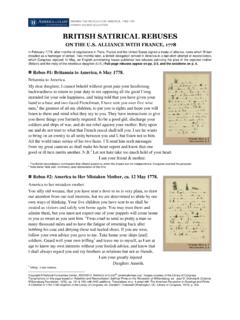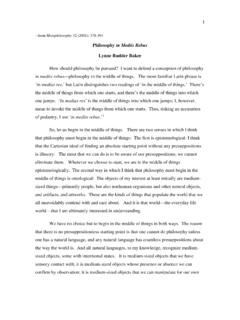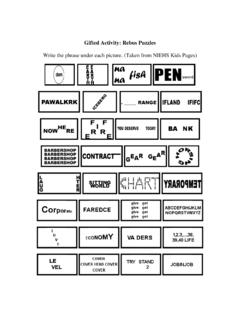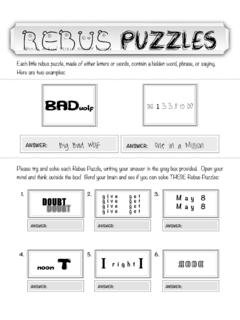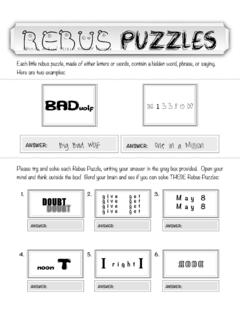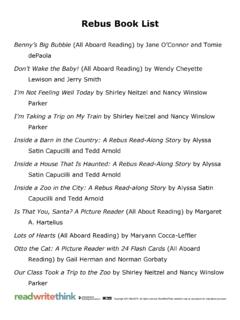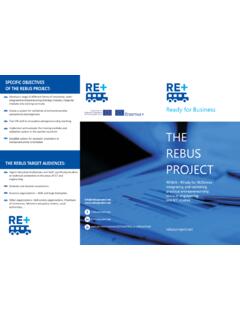Transcription of Table of Contents - Speech Corner
1 3 Articulation Stories For Carryover Practice 2013 Speech Corner Table of Contents Introduction 5 Guidelines for Use 6 /f/ 7 Initial 7 Medial 11 Final 15 Mixed 19 th 23 Initial 23 Medial 27 Final 31 Mixed 35 sh 39 Initial 39 Medial 43 Final 47 Mixed 51 ch 55 Initial 55 Medial 59 Final
2 63 Mixed 67 /l/ 71 Initial 71 Medial 75 Final 79 Mixed 83 /l/ Blends 87 /bl/ 87 /fl/ 89 /gl/ 91 /kl/ 93 /pl/ 95 /sl/ 97 /l/ Blends Mixed 99 /s/ 101 Initial
3 101 Medial 105 Final 109 Mixed 113 /s/ Blends 117 /st/ 117 /sp/ 119 /sk/ 121 /sm/ 123 /sn/ 125 /sw/ 127 /sl/ 129 /s/ Blends Mixed 131 /s/ Recurring 133 /r/ 135 /r/ Initial 135 /ar/ Mixed 139 /or/ Mixed
4 143 /ire/ Mixed 147 /air/ Mixed 151 /ear/ Mixed 155 /er/ Mixed 159 /r/ Mixed 163 /r/ Blends 167 /br/ 167 /fr/ 169 /gr/ 171 /kr/ 173 /pr/ 175 /tr/ 177 /r/ Blends Mixed 179 Master Sheets 181 5 Articulation Stories For Carryover Practice 2013 Speech Corner Articulation Stories For Carryover Practice was created to allow Speech -language pathologists a convenient
5 Way to provide advanced-level articulation remediation for their students. A student s ability to take the Speech skills that he/she has learned in the therapy room and use them in all speaking situations comes naturally to some, while others need multiple opportunities to practice. This reproducible workbook allows such practice. Reading short passages and answering questions are common academic tasks that students in schools are routinely asked to do in reading, science, and social studies. This workbook provides this familiar format and incorporates specially selected target words to maximize articulation production opportunities. Articulation Stories For Carryover Practice is a reproducible workbook that contains a collection of 170 stories for 16 popular phonemes (f, th, sh, ch, l, l-blends, s, s-blends, r, r-blends, and vocalic ar, or, ire, air, ear, er.) The phonemes are further divided into sound positions (initial, medial, final, and mixed), with the exception of the blends which are initial position and the vocalic /r/ allophones which are mixed.
6 This provides the therapist with a wide selection of appropriate targets to choose from in one convenient book. In addition, there are two story formats to choose from, rebus or traditional articulation stories. rebus stories contain pictures of target words and shorter reading passages for beginning or struggling readers. Traditional articulation stories contain longer reading passages that are loaded with target words to maximize production opportunities. Both types of stories have comprehension questions that follow the reading passages. The questions are strategically structured in allowing answers that would have target words within them. I hope you will find the articulation stories and follow-up questions useful, effective, and reliable for carryover practice for the students you serve. Introduction 6 Articulation Stories For Carryover Practice 2013 Speech Corner Designed with the busy Speech -language pathologist in mind, the following is a brief synopsis about how to use this book.
7 Choose an appropriate articulation target sound. Decide if your student needs a rebus (picture) or a traditional articulation (no picture) story. Select and photocopy a corresponding articulation story sheet by locating it in the Table of Contents . Give the student the page. Review the target vocabulary located in the Vocabulary Bank with the student. Allow the student to read the story out loud. Ask the student the questions that follow. Converse about the answers to facilitate more elaborate carryover practice. Remember that even if students are proficient readers, they often enjoy reading rebus stories. Be sure and use them with all students that you believe would benefit from them, not only those with limited reading abilities. Guidelines for Use 7 Articulation Stories For Carryover Practice 2013 Speech Corner Review the target words in the Vocabulary Bank. Read the story and then answer the questions that follow.
8 Name _____ rebus Stories /f/ Initial Having Fun Playing Games Felix Felix wants Michael to come over to play board games. He calls Michael on the phone and Michael comes over. Felix gets some fish crackers for them to snack on while they play games. They have fun playing games. Michael won first, but Felix was a good sport and didn t start a fight. He just wanted to play again! fun phone fight fish crackers first Vocabulary Bank 1. Who did Michael play board games with? 2. How did Michael talk to Felix? 3. What snack did the boys eat? 4. How did the boys feel while playing games? 60 Articulation Stories For Carryover Practice 2013 Speech Corner Review the target words in the Vocabulary Bank. Read the story and then answer the questions that follow. Name _____ rebus Stories ch Medial Scoring a Touchdown Against the Vultures bleachers My family was sitting on the bleachers and eating nachos while watching my brother play in a football game.
9 His team was playing against the Vultures. During the next play, my brother caught the ball and was running in for a touchdown. He was tackled and broke his leg. He might need a wheelchair or the use of crutches until his leg heals. touchdown nachos Vultures crutches Vocabulary Bank 1. Where was the family sitting? 2. What was the mascot of the visiting team? 3. What snack was the family eating? 4. What might the brother need to use while his leg is healing? wheelchair 145 Articulation Stories For Carryover Practice 2013 Speech Corner Review the target words in the Vocabulary Bank. Read the story and then answer the questions that follow. Name _____ Articulation Stories /or/ Mixed 1. Who wanted a snack? 2. What time of day did he want the snack? Wanting an Oreo Vocabulary Bank floor dinosaurs story Orson wanted a snack this morning. Nora told Orson to pick up his toys off the floor and then he could have an Oreo.
10 He had dinosaurs, story books, and sports equipment all over the floor. Orson wanted the Oreo cookie, so he picked up all of the toys. It was important to Nora that Orson picked up the toys because he had made a mess. When the floor was all clean, she gave Orson an Oreo and he loved it! Nora Orson Oreo sports important morning 3. What did Nora tell him he had to do in order to get a snack? 4. What snack was he going to get if he did his chore? 5. What types of toys were on the floor? 6. When the floor was all clean, what did Nora do?

